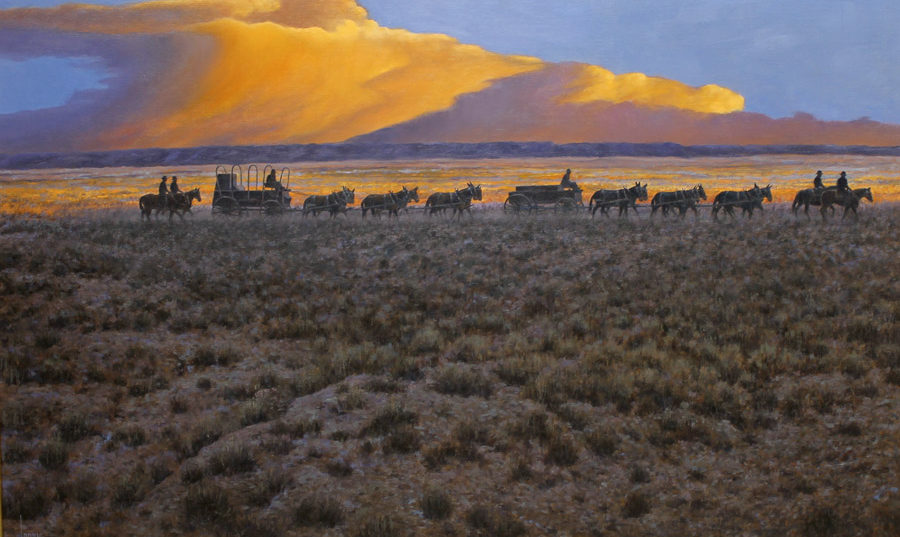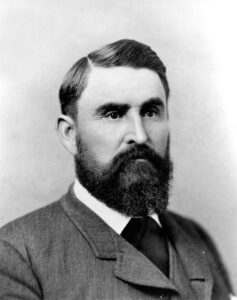
Lee Cable’s oil painting ‘A Promise Made, A Promise Kept.’ Courtesy Lee Cables.
Legendary Texas rancher Charles Goodnight was born in Illinois on March 5, 1836. One day later, in San Antonio de Bexar, the Alamo fell to the Mexican army. Before his 10th birthday, Goodnight rode bareback behind his family’s wagon as they trekked southwest to Texas, the newest state in the Union. By the time of his death in 1929 at the age of 93, the weathered trailblazer was revered as “the Father of the Texas Panhandle” for founding the JA Ranch, the region’s first cattle ranch.
You can see more of the Goodnight legend in an exhibition of oil paintings that depict his life and times at the Albert & Ethel Herzstein Museum Gallery in Houston. On loan from the Bryan Museum in Galveston and presented by the Heritage Society, the collection features six paintings and six preparatory sketches for the paintings by Colorado-based artist Lee Cable.
“I knew a little about Goodnight when [Houston businessman and philanthropist] Jim Parkman first approached me about commissioning the paintings,” Cable says. “But when I read more about his life, I was enthralled. For one thing, it’s amazing that he survived with all the wrecks and mishaps he had on the trail.

Photo courtesy University of North Texas Libraries/The Portal to Texas History; Cattle Raisers Museum
Cable’s painting Giving Counsel recalls the Goodnight-Loving Cattle Trail that Goodnight blazed shortly after the Civil War with fellow cattleman Oliver Loving. According to the Handbook of Texas, published by the Texas State Historical Association, the trail started in Young County, followed the Pecos River into New Mexico, then on into Colorado, and ending in Cheyenne, Wyoming. Historians say that Goodnight invented the chuckwagon on the first trek up the trail. The painting depicts a night scene with cowboys gathered around the fire by the chuckwagon on a later drive, as Goodnight and Loving discuss the latter’s desire to ride ahead to Santa Fe where buyers are waiting to bid on cattle. Goodnight counsels against it.
Loving died in New Mexico territory, a victim of the gangrene that developed from wounds suffered in an attack by Native Americans. Goodnight promised to bury Loving in Texas, and the painting A Promise Made, A Promise Kept captures the funereal spirit of that mournful caravan back to Loving’s Weatherford home. If that story sounds familiar, it’s because it provided the framework for the cattle drive friendship of characters Woodrow Call and Gus McRae in the landmark novel and TV miniseries Lonesome Dove.
Cable’s Finding Cynthia Ann Parker illustrates the aftermath of an attack by Texas Rangers, U.S. cavalry, and members of a volunteer militia on a Comanche encampment along the Pease River in 1860. Goodnight, according to the Handbook of Texas, had located the trail to the camp and participated in the attack. Finding a blue-eyed Comanche woman, the Rangers learned that she was actually Cynthia Ann Parker, a white woman captured in 1836. Having married Comanche chief Peta Nocona and given birth to two children, she had adapted thoroughly to her captors’ way of life and her return to Anglo civilization brought anguish and despair.
One of Cynthia Ann’s children, Quanah Parker, became a great leader of Comanche people. Cable’s painting Quanah Parker speaks to the friendship that developed between Goodnight and Quanah. When Goodnight arrived at Palo Duro Canyon around 1876 or ’77 to start ranching operations in the area, he utilized poles remaining from former Comanche tipis to construct a temporary dugout as shelter. (The Red River War of 1874-75 had removed the last of the Southern Plains Indians from the area.) Later in the decade, a party of Comanches led by Quanah left the reservation and returned to the Palo Duro in search of bison. Goodnight befriended the men and provided them with beef until the army forced them back to the reservation. Parker and Goodnight remained lifelong friends, a relationship illustrated most poignantly in a scene in Mineral Wells’ Crazy Water Bathhouse in Jan Reid’s novel Comanche Midnight.
Two paintings in the exhibition, Old Blue and A Good Idea Gone Bad, reflect Goodnight’s relationships with animals. The Longhorn steer named Old Blue showed natural leadership amongst his brethren, and Goodnight outfitted him with a bell and made him the lead steer on numerous drives up the trail to Kansas railheads. A Good Idea Gone Bad offers a note on Goodnight’s relationship with the buffalo. In the spring of 1886, Cable explains, Goodnight rode out to bring an ornery bison named Old Sikes back to the ranch. But Old Sikes charged the rancher and chased him all the way home. “Goodnight was running for his life,” Cable says.
Parkman, the businessman who commissioned the paintings, donated the series—which eventually may encompass some 25 paintings—to Galveston’s Bryan Museum. Saddles and spurs in the exhibit, provided by the museum, will enrich the Old West experience, along with a touch cart for interactive learning and educational story boards. The exhibition will remain on view through next spring, and six more of Cable’s Goodnight works will be added to the show during the 2023 Houston Livestock Show and Rodeo. The Heritage Society’s grand opening for the exhibition will also be held during the rodeo.
Goodnight’s real-life adventures need no embellishment. However, in a gallery talk for a previous showing of the paintings, Cable confessed that he did take at least one poetic liberty with the rancher’s story. “He didn’t like cowboy boots,” the artist explained. “He wore brogan boots. So I put him in cowboy boots … I just thought, ‘Damn it!’”








